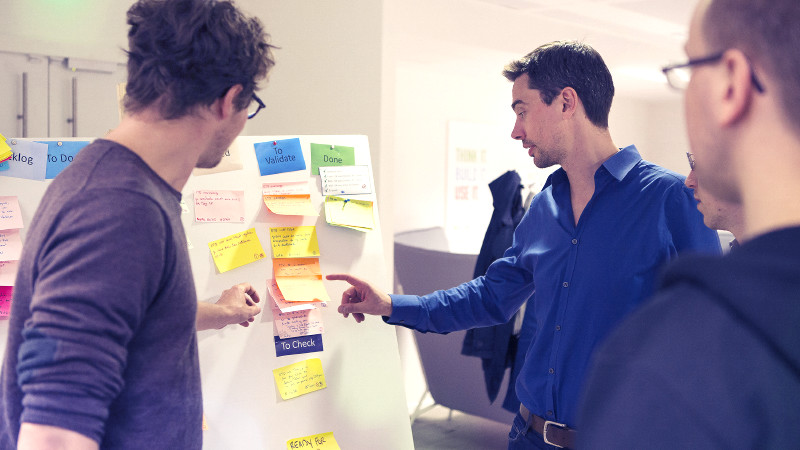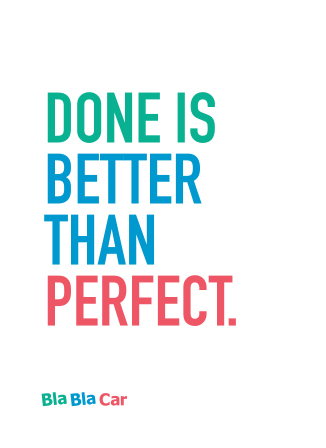There is no such thing as perfection. If BlaBlaCar were to have waited for the perfect product to be created before launching online, it wouldn’t be where it is today. In the same way that a ship should be placed in water during production to see if it floats. If it sinks, you’ll quickly find the hole and fix it. If it floats, your focus will shift to making it even better. That’s the premise behind BlaBlaCar’s core value “Done is better than perfect” which works in tandem with “Never Assume, Always Check”. These two values ensure that whichever element or feature is released has a significant chance of developing into a success story.
Looking back to the early days, the first version of BlaBlaCar’s platform could only handle up to 100,000 members. Any more volume, and it would explode. But that didn’t stop Fred from putting it online to test whether it worked. When Francis joined BlaBlaCar full-time in 2008, he took what Fred, Damien and Nico D had developed and shaped the architecture to withstand a further 5 million members. A few years later as BlaBlaCar expanded internationally, Francis lead the charge in transforming the platform to sustain future growth. Today, the platform currently holds 35 million members and Francis, together with the rest of team, continue to evolve it every day.
When BlaBlaCar first launched in Spain in 2009, the country manager Vincent Rosso, a former colleague of Fred, and his team had wanted to add many features to ensure people would like the service the first time they used it. They soon realized that it would be more efficient to release the product as it is and just focus on listening to its members instead. A much faster way to converge a product, they could trust that if something didn’t work, people will shout and let their thoughts be known. In a world where speed of innovation is a key factor of success, a startup can’t afford to have a static product.
Finding the Signal
Building the right product is a state of mind. It’s about achieving something ambitious, yet realistic. To this day, one of the most difficult parts of product conception inside BlaBlaCar is separating the signal from the noise. There are thousands of features that people want developed but there are only a dozen that they would really use and which would truly improve their experience. Finding those specific features is hard but in the long run is much more efficient than developing all the nice-to-have features. It’s much more powerful to ask 50 people the 1 or 2 features that need to be added, rather than asking a few people for the 50 features they’d like to see implemented.
From Fred cold-calling members and gathering their feedback in the early days to today’s 130 people strong Member Relations Team who collate feedback and the Product team who organize regular user testing and focus groups, BlaBlaCar remains constantly engaged with their members. After all, the Member is always the Boss! When a fair proportion of the members mention the necessity of a feature, that’s when the team weighs the importance and start to understand the real value behind it. When BlaBlaCar launched in India, the team realized that members were whatsapping images of their ID to each other before their journey to ensure they were who they said they were. Upon hearing this repeatedly in feedback sessions, BlaBlaCar introduced the Government ID verification feature. Members can now verify their passport securely and confidentially on the platform and as a result “Govt. ID verified” is displayed on their profile. This feature optimizes a member’s reliability level and adds an extra layer of trust and safety.
Release and listen!
Once the signal is separated from the noise, the team sets out to build a Minimum Viable Product (MVP) which encompasses the basic framework. Put simply, if someone wants to build a car, one shouldn’t start by building the engine first as an engine alone won’t make a car. Instead an MVP could be a skateboard, which encompasses the basic characteristics of a car: four wheels and the ability to move an individual from A to B. These basic features and framework are critical to test before any further innovation takes place. Once the prototype is delivered, the team select a specific axis to test the feature on before all feedback from members is collected and analyzed. If members are happy with the new feature and tend to use it, then a more comprehensive and robust implementation of the feature takes place and is gradually rolled out to the rest of the members across the globe.

When the roll-out of online booking took place in France in 2011, it called for a big shift in BlaBlaCar’s members’ behaviour. Passengers had been used to paying cash in hand to the driver after a journey and now had to adjust to online payment. After several months of development, the first version of the product was delivered and the team decided to implement it on one particular route, for the simple reason that if something went wrong, it would affect just a few people in a limited area. The team actively listened to members who were trying the product real-time and speedy iterations were needed to reduce the accompanying frustrations that some members were experiencing. One recurrent complaint was that drivers didn’t appreciate the automatic approval upon receiving a booking. Instead they wanted the opportunity to validate their requests manually. In the first month alone, the team reiterated the product over 20 times.
Most of the teams in the company are critical in the development and implementation of the product. The Founders help to prioritize the execution and direction in crafting the entire service. The Member Relations team are in contact daily with members and can tell very quickly if something needs to be improved from a member’s point of view. The Product Manager acts as a bridge between the member’s need and the technical solution. The Tech team are the ones who transform ideas into reality, whilst building and coding the platform. The Product team then analyze the product, and measure the behaviours and impressions that members feel at each step of the experience. The Communications team are in contact with the community to spread the message. And the People team hire the right talent to make it all happen.
Agile at BlaBlaCar’s core
Building a product is all about iterations and continuous improvement and that’s why employees are encouraged to adopt an agile mindset. A common approach in the startup world, the agile philosophy is a time-focused, iterative approach which allows a product to be built step-by-step. Instead of delivering the product all at once, it’s a dynamic process that allows course corrections as you go. As a result, it provides the ability to adapt and change at any point.
A strong believer in building for the long-term, Francis’ passion is infectious and encourages the tech team to focus on the robustness of the solution when building any feature. Until 2015, the tech team was originally made up of five teams: TeamRed focused on mobile development and apps; TeamGreen developed the desktop browser, internet and web mobile versions; TeamBlue concentrated on all aspects of monetisation; TeamYellow developed all internet tools, and TeamPurple was responsible for infrastructure and technical scaling. As BlaBlaCar began to grow, the team also began to expand, and a significant shift was starting to take place. Their communication and feedback channel was no longer proving efficient.
With the agile mindset being at the core of BlaBlaCar, Francis knew what he had to do. Benchmarking successful startups, he formed a new organizational structure, based on “tribes and squads”. Likened to a start-up within a start-up, a “tribe” has has its own mission and is made up of a cross-functioning and complementary team to deliver on its objectives. It has an appointed Need lead, a Product lead and a Tech lead, as well as several squads made up of developers, designers and analysts. The whole team is involved early in building the roadmap together which leads to more ownership and commitment from all those involved. As a result of direct interaction between team members, more alignment and better solutions are achieved. Furthermore, all tasks are parallelized, meaning there are no dependencies between teams which ultimately leads to faster delivery. At BlaBlaCar, four tribes are currently in place, including the Satisfy & Care tribe, Monetize tribe, Trust tribe and the Grow & Engage tribe. These tribe names are purposely made up of an actionable verb: Tribes are Missions and Missions must lead to Action!
Keeping the agile mindset in check
Rolling out new product features frequently and getting instant feedback is certainly motivating. But to do it right requires a significant level of trust amongst employees. In one of the previous articles, you may have discovered BlaBlaCar’s “Fail, Learn, Succeed” value and how failure is inherent to the overall learning process. Having established a fail-friendly environment at BlaBlaCar encourages employees to try new things and ultimately allows them to improve faster and continue to innovate.

Several methodologies such as Kanban and Scrum have also been benchmarked over the years and are in place to help teams achieve agility, foster collaboration and allow for continuous improvements. Daily scrum stand-ups, in particular, are notorious. Walking through the office, you’ll see various teams holding 15 minute stand-up meetings at the same time, every morning. It allows the team to synchronize their activities, discuss what worked and what didn’t work and together create a plan for the next 24 hours. Teams often critique the process used and create improvement plans to be enacted next time.
Like everything in BlaBlaCar, everything grows from a simple idea. If an individual or a team overplan and think they need to build something which has to be perfect, it’s paralysing. Only when the agile mindset takes hold are teams able to seize new opportunities, adapt continuously and innovate faster. At the end of the day, they’re playing with the only true constant, which is change.
